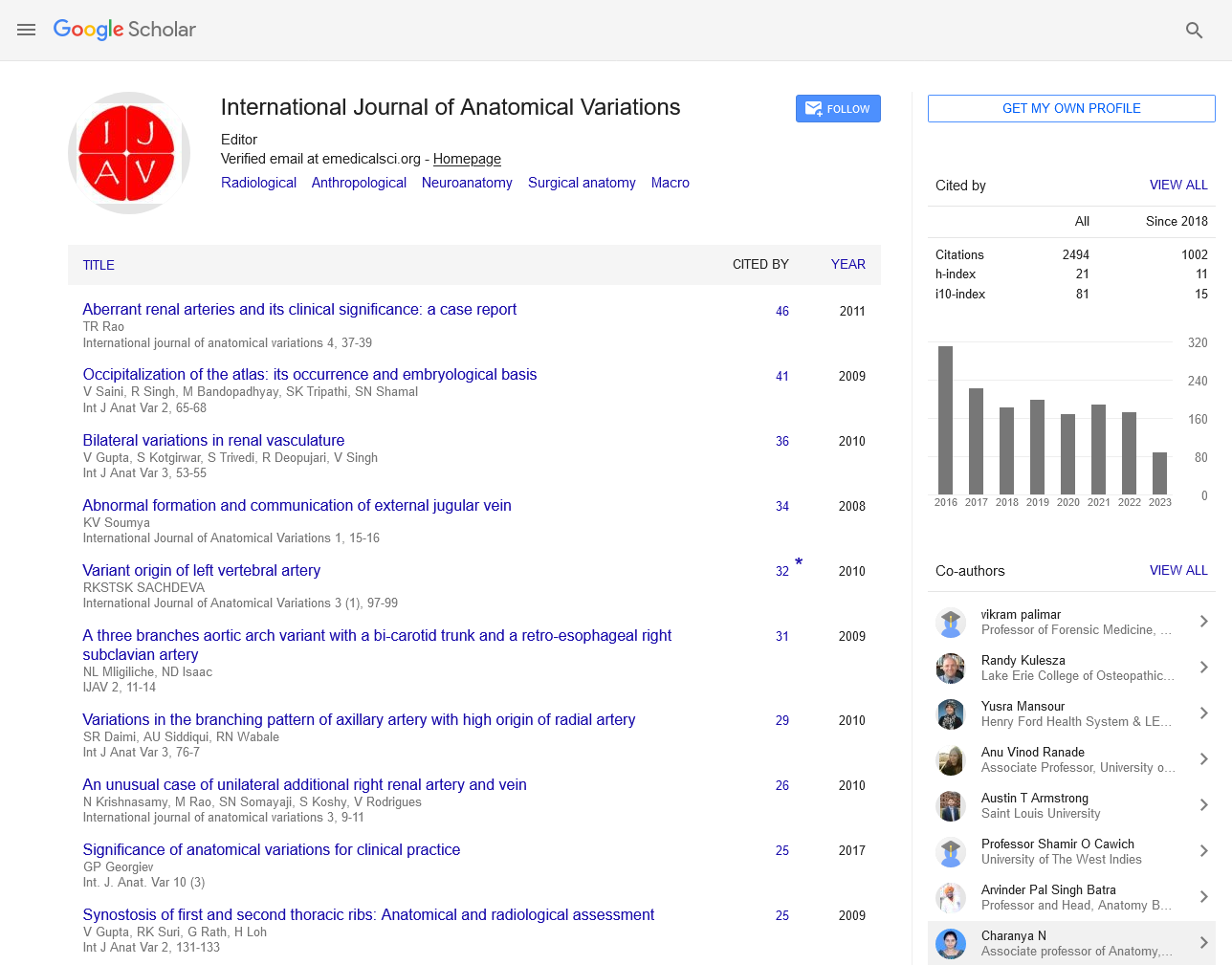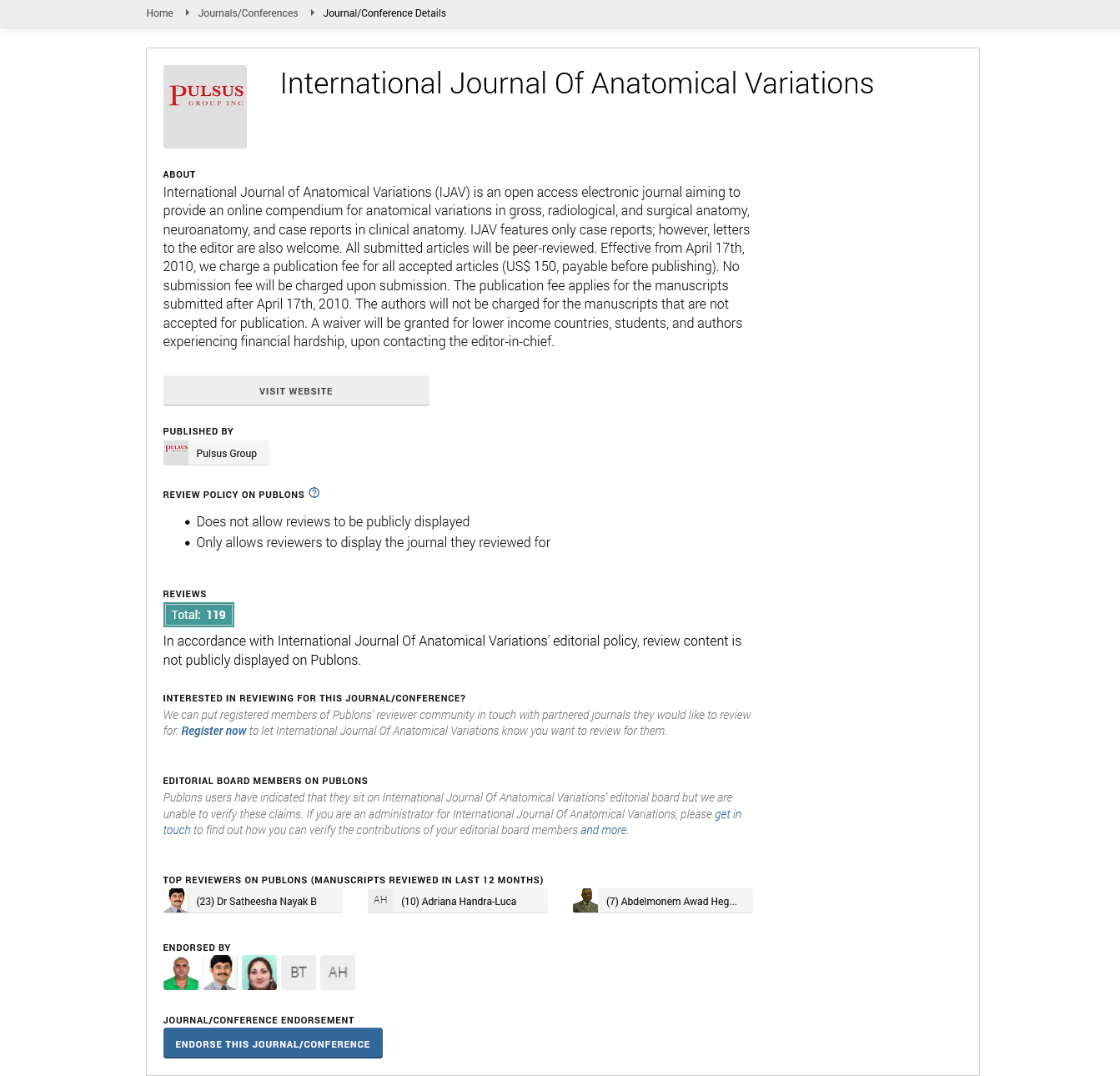A Comprehensive Overview of Human Anatomy Structural Foundations of the Human Body
Received: 01-Apr-2025, Manuscript No. ijav-25-7667; Editor assigned: 04-Apr-2025, Pre QC No. ijav-25-7667 (PQ); Reviewed: 21-Apr-2025 QC No. ijav-25-7667; Revised: 26-Apr-2025, Manuscript No. ijav-25-7667 (R); Published: 30-Apr-2025, DOI: 10.37532/13084038.18(4).501
Citation: Singh K. A Comprehensive Overview of Human Anatomy Structural Foundations of the Human Body. Int J Anat Var. 2025; 18(4): 772-773.
This open-access article is distributed under the terms of the Creative Commons Attribution Non-Commercial License (CC BY-NC) (http://creativecommons.org/licenses/by-nc/4.0/), which permits reuse, distribution and reproduction of the article, provided that the original work is properly cited and the reuse is restricted to noncommercial purposes. For commercial reuse, contact reprints@pulsus.com
Abstract
Human anatomy, the scientific study of the body’s structures, is a cornerstone of medical and biological sciences. This article explores the foundational aspects of human anatomy, categorizing it into gross (macroscopic) anatomy and microscopic anatomy (histology). It examines the major organ systems, their components, and their interrelations that maintain homeostasis and facilitate life. Through an integrative approach, this paper emphasizes the importance of anatomical knowledge in clinical practice, biomedical research, and health education.
INTRODUCTION
The study of human anatomy dates back to ancient civilizations, yet it remains one of the most crucial disciplines in health sciences [1]. Understanding human anatomy is vital for diagnosing disease, performing surgery, and interpreting physiological functions. Anatomical science is divided into several subfields, including gross anatomy, which involves structures visible to the naked eye, and microscopic anatomy, which studies cells and tissues under the microscope. This paper provides a detailed review of the structure of the human body, organized by systems, highlighting the significance of each in maintaining the organism's integrity and function. Human anatomy, the study of the body's structural organization, serves as a cornerstone in the fields of medicine, biology, and allied health sciences. It encompasses the intricate architecture of cells, tissues, organs, and systems that collectively sustain life [2]. A comprehensive understanding of human anatomy is essential for medical professionals, as it underpins the diagnosis and treatment of diseases, guides surgical procedures, and informs the development of medical technologies. The human body exhibits a hierarchical structural organization, beginning at the chemical level with atoms and molecules, progressing through cells and tissues, and culminating in complex organ systems that perform specialized functions. This organization ensures the maintenance of homeostasis and the body's adaptability to internal and external changes. Anatomical studies are traditionally divided into gross anatomy, which examines structures visible to the naked eye, and microscopic anatomy, which explores cells and tissues using magnification tools. Advancements in imaging technologies, such as MRI and CT scans [3], have revolutionized the study of anatomy, allowing for non-invasive visualization of internal structures and enhancing our understanding of the human body's complexity. These tools have become indispensable in educational settings and clinical practice, facilitating accurate diagnoses and effective treatment planning. This article aims to provide a comprehensive overview of human anatomy, detailing the structural foundations of the human body and highlighting their relevance in clinical contexts. By exploring the various organ systems and their interrelationships, we seek to elucidate the intricate design that enables human life and health [4].
GROSS ANATOMY
Gross anatomy, also known as macroscopic anatomy, refers to the study of body structures that are visible to the naked eye. It forms the foundation of anatomical education and is primarily concerned with the organization and relationships of organs, tissues, and systems within the human body. Traditionally taught through cadaver dissection, gross anatomy provides a hands-on approach to understanding the spatial orientation and functional integration of bodily structures. This branch of anatomy is typically subdivided into regional anatomy [5], which focuses on specific areas of the body such as the head, neck, or abdomen, and systemic anatomy, which examines individual organ systems like the skeletal, muscular, or circulatory systems. Gross anatomical knowledge is essential for clinical practice, as it enables healthcare professionals to navigate the human body during physical examinations, surgical procedures, and diagnostic imaging. In recent years, technological advancements such as 3D modeling and virtual dissection have enhanced the study and teaching of gross anatomy, offering more interactive and detailed explorations of the human form.
SKELETAL SYSTEM
Comprising 206 bones in the adult body, the skeletal system provides structural support, protection for internal organs, and a framework for muscle attachment. It also plays a key role in hematopoiesis (blood cell formation) and mineral storage. The skeletal system forms the structural framework of the human body, providing support, protection, and facilitating movement. Comprising 206 bones in the adult human body, it is categorized into the axial skeleton—which includes the skull, vertebral column, and rib cage—and the appendicular skeleton, consisting of the limbs and girdles. Beyond its mechanical functions, the skeletal system plays a crucial role in physiological processes. Bones house the bone marrow, which is essential for hematopoiesis—the production of blood cells. Additionally, the skeleton serves as a major reservoir for essential minerals such as calcium and phosphorus, which are released into the bloodstream as needed to maintain mineral balance and support metabolic functions. Joints, ligaments, and cartilage further contribute to the system by connecting bones and enabling a wide range of movements while ensuring stability and flexibility. The continuous process of bone remodeling, driven by osteoblasts and osteoclasts, allows the skeleton to adapt to mechanical stresses and repair micro-damages, underscoring the dynamic and responsive nature of this vital system.
TECHNOLOGICAL ADVANCEMENTS IN ANATOMY
Modern anatomical study benefits greatly from imaging techniques like MRI, CT scans, and ultrasound. 3D modeling and virtual dissection tools have revolutionized anatomy education and surgical planning. These technologies provide detailed views of structures without invasive procedures.
CLINICAL RELEVANCE
Anatomical knowledge is indispensable in clinical settings. Accurate understanding of anatomical variations aids in diagnostics, surgical interventions, and physical examinations. Pathologies such as congenital malformations, trauma, and neoplastic changes are better understood through anatomical context.
CONCLUSION
Human anatomy is a vast and vital field that underpins all medical and biological sciences. A detailed knowledge of body structures and their functions enables effective diagnosis, treatment, and innovation in healthcare. Continued exploration and technological integration will further enrich our understanding of the human body.
REFERENCES
- Cui RR, Wright JD, Hou JY. Uterine leiomyosarcoma: a review of recent advances in molecular biology, clinical management and outcome.BJOG: Int. J Obstet Gynaecol. 2017; 124(7):1028–1037.
- Santos P, Cunha TM. Uterine sarcomas: Clinical presentation and MRI features.Diagnostic and Interventional Radiology. 2015; 21(1):4–9.
- Cree IA, Tan PH, Travis WD, Wesseling Pet al.Counting mitoses: SI (ze) matters!Modern Pathology. 2021; 34:1651–1657.
- Huang YT, Huang YL, Ng KK, Lin G. Current status of magnetic resonance imaging in patients with malignant uterine neoplasms: A review.KJR. 2019; 20(1):18–33.
- Hughes L, Roex A, Parange A. STUMP, a surprise finding in a large fibroid uterus in a 20-year-old woman.Int J Womens Health. 2018; 10:211–214.
Indexed at, Google Scholar, Crossref
Indexed at, Google Scholar, Crossref
Indexed at, Google Scholar, Crossref
Indexed at, Google Scholar, Crossref






